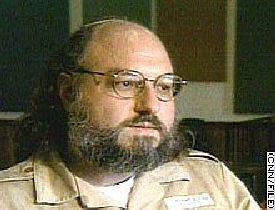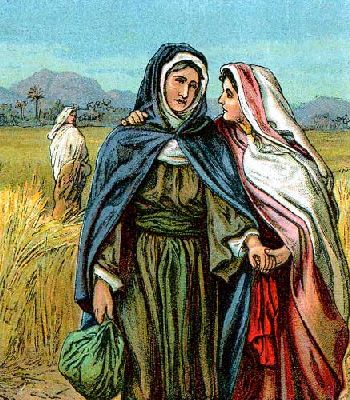

In reflecting on Shavu’ot and the story of Ruth, I am struck by the similarity between Ruth’s cleaving to Naomi and to Jewishness, and Jonathan Pollard’s actions on behalf of Israel and B’nai Yisrael — putting his life on the line, the price — come what may, for the survival of the Jewish people in Eretz Yisrael — Our Land.
Jonathan is not a Ger Tzeddek as Ruth was when she clung to Naomi saying;
“Do not urge me to leave you, to go back and not follow you. For wherever you go, I will go; where you lodge, I will lodge; your people are my people, and your G’d is my G’d; where you die, I will die and there I will be buried. Thus may Hashem do to me — and more! — if anything but death seoarates me from you.” (Megillat Ruth, Artscroll Tanach series, Perek 1, posukim 14-17, pages 79-81)
There was no mandate, no earthly obligation for Ruth to follow Naomi. She could have done what her sister-in-law Orpah did — they were both widowed of Naomi and Elimelech’s sons Machlon and Kilyon. When after the deaths of her husband and two sons, Naomi sought to return to Eretz Yisrael and bid the two widows to return to their Moabite people and land. Orpah tearfully left Naomi and returned to Moav, while Ruth clung to Naomi and her Jewishness thus charting her life unalterably along a Jewish path.
In much the same way, Jonathan Pollard, Yehonaton ben Malka, then working in the US defense department, could have taken the easy path — the path undoubtedly taken by many others, to just do his job without a thought to his people. He would have been free man, not incarcerated for some 25 years — but where would Israel be??
Pollard was not under any earthly superior’s orders to provide the dire intelligence which Israel needed to protect herself from what was then an Iraqi nuclear threat and to eliminate that threat.
But just as Ruth heard a Divine Imperative, the full extent of which she probably didn’t near fully comprehend — the lineage of Jewish Kingship, so too Jonathan Pollard acted on internal impetus and initiative in service of a Divine Imperative — the security and wellbeing of his people.
The concept of promoting learning all night on Shavu’ot L’Zechut Jonathan Pollard came about last Shavuot as an enlargement of this author’s concept of devoting one Thursday night Mishmar per month L’Zechut Jonathan, and out of a recognition that the long-established policy of current and successive previous Israeli and American governments of forsaking Jonathan is impervious to earthly efforts to affect pressure on his behalf to bring about change in this now long-standing policy. Earthly appeals for clemency have fallen upon deaf-ears due to the outrageous and grievous absence of any efforts on Jonathan’s behalf by governments of Israel.
We are faced with a US president openly hostile to Israel in every way, despite having been elected with the help of an overwhelming Jewish vote (81%). The possibility of earthly effective appeal on Jonathan’s behalf to the current president is, at best, more remote than ever, if not non-existent.
This author heard a thought expressed by a well-known Rabbi in the months just prior to the expulsion of Jews from Gush Katif and the 4 Shomron towns which took place in August, 2005. The Rabbi indicated that as long as there are actions Derech HaTeva (earthly actions which are possible) that we can take regarding a Gezeira, a matzav — we must act on them as we continue our prayers. Once all such earthly actions have been taken and have proven fruitless, we then focus and direct all of our energies to beseeching The Ultimate Avenue of Appeal — Hashem in Shemayim. In this author’s humble opinion, those working, acting and striving on Jonathan’s behalf have reached that point. It is now time to focus our strengths, resources and spirituality on reaching and beseeching Shemayim DIRECTLY on behalf of Jonathan Pollard.
The inspiration for dedication of Shavu’ot all-night learning L’Zechut Yehonatan Ben Malka comes from the Shavu’ot night incident which involved R’ Shlomo HaLevi AlKabetz (Turkey 1505 – Tzfat, Eretz Yisrael 1584) and R’ Yosef Karo – author of the Shulchan Aruch, as cited in the Artscroll Shavu’ot Machsor (pages 68-69). The incident described serves as a paradigm for contemporary Shavu’ot night learning. There is also a shorter rendition of this incident in Wikipedia:
The custom of all-night Torah study goes back to 1533 when Rabbi Joseph Caro, author of the Shulchan Aruch, then living in Ottoman Salonika, invited his Kabbalistic colleagues to hold a night-long study vigil, in the course of which an angel appeared before them and commanded them to go live in Eretz Yisrael. According to a story in the Midrash, the night before the Torah was given, the Israelites retired early to be well-rested for the momentous day ahead, but they overslept and Moses had to wake them up because God was already waiting on the mountaintop. To rectify this flaw in the national character, religious Jews stay up all night to learn Torah.
Any subject may be studied, although Talmud, Mishna and Torah typically top the list. In many communities, men and women attend classes and lectures until the early hours of the morning. In Jerusalem, thousands of people finish off the nighttime study session by walking to the Kotel before dawn and joining the sunrise [Naitz] minyan there. The latter activity is reminiscent of Shavuot’s status as one of the three Biblical pilgrimage festivals, when the Jews living in the Land of Israel journeyed to Jerusalem to celebrate the holiday.
Tikkun Leil Shavuot In keeping with the custom of engaging in all-night Torah study, the Arizal, a leading Kabbalist of the 16th century, arranged a special service for the evening of Shavuot. The Tikkun Leil Shavuot (”Rectification for Shavuot Night”) consists of excerpts from the beginning and end of each of the 24 books of Tanakh (including the reading in full of several key sections such as the account of the days of creation, The Exodus, the giving of the Ten Commandments and the Shema) and the 63 chapters of Mishnah. This is followed by the reading of Sefer Yetzirah, the 613 commandments as enumerated by Maimonides, and excerpts from the Zohar, with opening and concluding prayers. The whole reading is divided into thirteen parts, after each of which a Kaddish di-Rabbanan is recited when the Tikkun is studied in a group of at least ten Jews.
May we, the B’nai Yisrael be zocha that our brethren — the refugee families from Gush Katif be permanently settled and be made totally whole, that our dear brother Jonathan Pollard, captive Gilad Shalit and the other MIAs be liberated alive returned to us in ways befitting Al Kiddush Hashem. May we have the courage to prevent the possibility of Chas V’Challila any future eviction of Jews from their homes and the handing of Jewish land over to enemies sworn to Israel’s and Judaism’s destruction and eradication. May we fulfill Hashem’s blueprint of B’nai Yisrael as a Unique people — an Am Segula, not to be reckoned with as with “the nations” and may we be zocha to see the Moshiach, the Ge’ula Shlaima, as Dov Shurin sings; “Ki Karov Yom Hashem V’Kol HaGoyim”, the Ultimate Redemption, bim hay v’yameinu — speedily, in our time”, — Achshav, Chik Chuk, Miyad, Etmol!!!
Chag Kosher V’Same’ach!
**************************************************************
Moshe Burt, an Oleh, is a commentator on news and events in Israel and Founder and Director of The Sefer Torah Recycling Network. He lives in Ramat Beit Shemesh.
***************************************************************